|
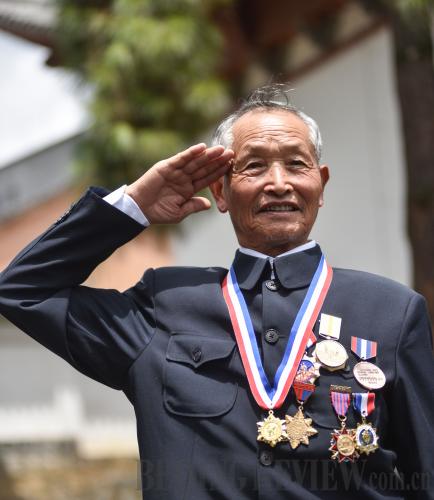 |
|
Veteran soldier Lu Caiwen salutes at the National Cemetery in Tengchong, southwest China's Yunan Province, on August 13 (WEI YAO) | The old man at the cemetery stands erect, belying his 89 years. Dressed in a dark-colored Chinese suit with an array of medals on his chest, he is a symbol of the painful part of history that remains etched in the consciousness of the Chinese nation.
Veteran soldier Lu Caiwen paid a visit to the National Cemetery in Tengchong County, southwest China's Yunnan Province, on August 13. He was there to pay his respects to many of his fallen war comrades, who died in the battles against Japanese aggression in Yunnan during World War II (WWII).
The majority of soldiers buried at Tengchong National Cemetery were killed during the battle to reclaim Tengchong in 1944. The cemetery contains gravestones for 3,346 soldiers from the 20th Group Army of China Expeditionary Force, 19 allied troops and another 19 Chinese soldiers who were killed in Burma.
In 2013, a memorial hall was built near the cemetery, commemorating the history of resistance against Japan's aggression in Yunnan and showcasing the great contribution of the China Expeditionary Force.
On the occasion of the 70th anniversary of victory of the Chinese People's War of Resistance Against Japanese Aggression, or the war of resistance, the number of visitors to the cemetery has doubled to 4,000 or 5,000 a day in the past year. During the July and August summer school holidays many parents take their children to the cemetery to educate them about the martyrs who died while defending their motherland.
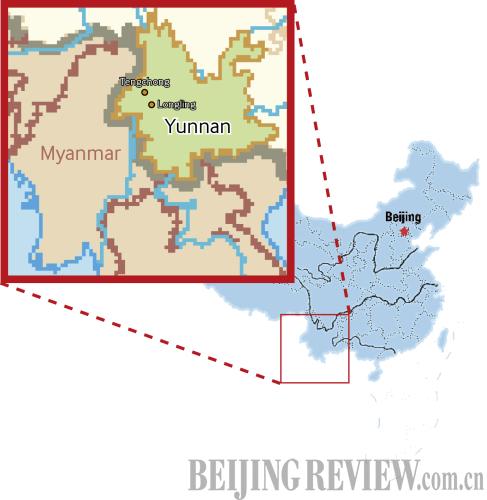
Youth at war
Lu was born and brought up in Tengchong. He was 16 years old when Japanese troops invaded Yunnan via their occupied Burma, today's Myanmar, in 1942. He was soon recruited by the famous Huangpu Military Academy and due to the escalating intensity of the war Lu's three-year training was reduced to only one year.
After graduation, Lu was posted to the intelligence unit of China's 11th Group Army with the rank of second lieutenant. The 17-year-old was sent to enemy-occupied territory in Tengchong and Longling in west Yunnan to gather intelligence on the Japanese army.
His skills in obtaining vital intelligence saw Lu promoted to full lieutenant. In January 1945, seven months before the Japanese army surrendered to China, west Yunnan was retaken by the Chinese army and Lu was honorably discharged, returning to school to further his studies. He later worked as a teacher for more than 40 years until his retirement.
Seventy years ago, there were around 3,000 Huangpu Military Academy graduates who came from Tengchong. Today, eight of them are alive. As the youngest of these, Lu heads up the Tengchong branch of alumnus sodality of the academy.
The remaining veterans are living in several towns of Tengchong. On occasions like the traditional Tomb-Sweeping Day or Victory Day of the War of Resistance, they visit the National Cemetery to lay wreaths for their fallen comrades.
"Many of my military school fellows were killed in the war. I miss them very much," said Lu.
When asked if he still feels any animosity toward the Japanese, he smiled and said both Chinese and Japanese should learn to understand each other in pursuit of finding peace, instead of continuing with feelings of resentment.
Counterattack
In 1940, almost all harbors along China's coastline were under the control of the Japanese army, with the only available international passage being the Burma Road. According to statistics, the volume of military and other important materials transported into China from the United States, Britain and the Soviet Union totaled 132,000 tons during 1941.
After the submission of Burma in 1942, however, the Burma Road was cut off and China's war of resistance entered an unprecedentedly difficult situation. To help continue providing vital supplies to keep the Chinese Nationalist Government in the war against Japan, the aircraft of the Chinese National Aviation Corporation (CNAC), in cooperation with the U.S. Army Air Transport Command, flew dangerous missions between Assam in India and Yunnan and Sichuan provinces in southwest China, known at the time as the world's longest military supply line. These aircraft remained in service right until victory was achieved in the war of resistance.
Because CNAC flew across the Himalayas and Hengduan Mountains, whose shape looks like the hump of a camel, the flight became known as the Hump Route.
It was the famous Flying Tigers, or American Volunteer Group, who flew as escorts for the CNAC supply aircraft on their treacherous route. Established in 1941 and lasting for five years, the Flying Tigers cooperated and assisted the Chinese Expeditionary Forces in terms of investigating the enemy situation, paradropping supplies, intercepting hostile aircraft, bombing Japanese positions and together with their escort duties along the Hump Route.
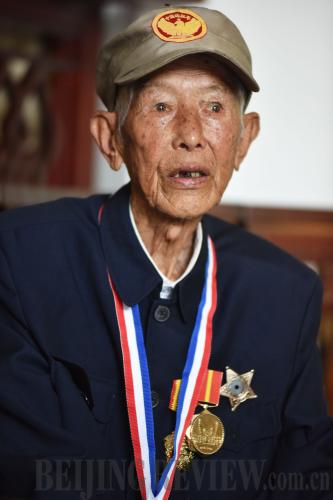 |
|
Veteran soldier Zhang Tiliu speaks in an interview in Tengchong, Yunnan Province, on August 13 (WEI YAO) |
When WWII entered the phase of international collaboration, the Chinese Expeditionary Force launched the strategic counterattack in west Yunnan. The 88-year-old veteran Zhang Tiliu was an eyewitness to the fierce fighting on those battlefields.
Beijing Review caught up with Zhang at the Memorial Cemetery on August 13. He recalled going to fight in Yunnan at the age of 17, after a brief period of training. As the squad leader of several units Zhang almost took part in all the counterattacks apart from the battle of Songshan Mountain. The crucial image of those battles is etched in his memory, especially the fighting in Nujiang River, Gaoligong Mountain, Laifeng Mountain, and Tengchong.
The first battle Zhang took part in during the war of resistance was the Yangtze River Crossing Campaign. "The roar of guns was ear-splitting. The machine guns strafed [us, sounding] just like letting off fireworks. I was terrified." As he became more experienced as a soldier he remembered being more calm in the heat of battle and learned to tell the direction of the enemy from the sound of their gunfire.
Today, the areas where Zhang and his comrades fought in the war remain as a memorial for their descendants and others.
On August 13 and 14, media from around the world visited the old battlefields, including Laifeng Mountain and Songshan Mountain. Li Caizhi, a researcher at the museum in Baoshan, to which Tengchong and Longling are affiliated, explained the past battles in details. The 60-year-old has spent most of his time studying local history and antiques related to the war of resistance in Baoshan.
In July 1944, as the strategic counterattack began, the China Expeditionary Force attacked the Japanese military position at Laifeng Mountain. The forces took control of the commanding height of Laifeng Mountain in Dangyue, which laid the foundation for the besiegement of Tengchong by the main force.
Today, Laifeng Mountain is the area with the largest and best preserved relics from the war. From the end of 2014, Li and his colleagues have been busy assembling the war relics for the Memorial Day of the Chinese People's War of Resistance Against Japanese Aggression and the 70th anniversary of the victory of the World Anti-Fascist War on September 3.
The war relics at Songshan Mountain, Longling, are also well preserved. Compared to the images on display in the museum showing a bare mountain destroyed by bombing and fire, it is now a peaceful green haven.
Wu Baozhang, a history professor at Yunnan Normal University, told Beijing Review that the West Yunnan Battlefield was the site of a turning point which marked the war's transition from strategic defense to strategic counterattack. The battlefield was, for the war of resistance for the Chinese people, as important as the Battle of Stalingrad was for the European war effort.
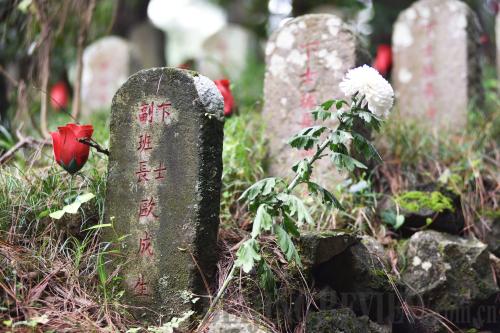 |
|
Tombstones in the National Cemetery of Tengchong, where 3,346 Chinese soldiers who died fighting against Japanese aggression in 1944 are buried (WEI YAO) |
Commemoration
On the ruins of Songshan Battlefield, workers rush about erecting structures for the commemoration of the resistance war in Yunnan on September 3.
According to Wang Ling, member of the Yunnan Steering Group commemorating the 70th anniversary of the victory of the Chinese People's War of Resistance Against Japanese Aggression and the World Anti-Fascist War, a series of memorial services are scheduled to be held throughout Yunnan. As the two most important regions, Tengchong and Longling in the city of Baoshan will be the venue for the memorial ceremony and commemoration activities. A total of 36 other memorial activities will also be held in Baoshan. Memorials will be held in cities such as Kunming, Dehong and Yuxi, respectively. A total of nearly 3,000 war veterans from across Yunnan have all been granted financial assistance by the state.
Some of the veterans will be invited to participate in the military parade to be held in Beijing on September 3. Lu is one of them. Lu repeatedly told the media that it was not yet confirmed whether or not he would make the journey, but it is a certainty that this marks the first time that a Kuomintang (KMT) veteran has been invited to such a state-level military parade.
In 2013, the Ministry of Civil Affairs (MOCA) documented that eligible former KMT veterans who fought Japanese aggressors are to be included in the social security system along with people in difficulties, and can be admitted into aged people's homes and welfare centers at the state's expense. Meanwhile, the MOCA also suggested that local Party committees and governments should invite former KMT veterans who fought Japanese aggressors to major festivals and offer them financial assistance.
The arrangement of having war of resistance veterans from both parties, the Communist Party of China (CPC) and the KMT, at the memorial, won the approval of Chinese netizens, who deemed it a manifestation of national confidence.
Wang told the media that this gesture shows an attitude of respect for history from both the CPC and the Chinese Government.
"Participating in the war of resistance to safeguard the nation is the biggest glory of my life. It is such a lucky thing for me to live until I receive the recognition from my country," said Lu.
Zhang also has no doubt he is fortunate. Zhang left the army after the victory of the war in 1945; however, he chose to neither pursue his studies nor return to his hometown in Sichuan Province. Instead he stayed on in Tengchong, where he settled and married, living together with his wife's family as is the local custom. He has lived in Tengchong for the past 70 years.
In January, with the assistance of volunteers, Zhang returned to his hometown in Meishan for the first time in seven decades. It was the fulfillment of a long-cherished dream for the old man, but since both his parents were long deceased, he could only pay his respects to them at their tombs.
Looking back on his life, Zhang is philosophical. "The best [thing] is peace. Once there is warfare, disaster [will come] to both sides," he said.
(Photos by Wei Yao)
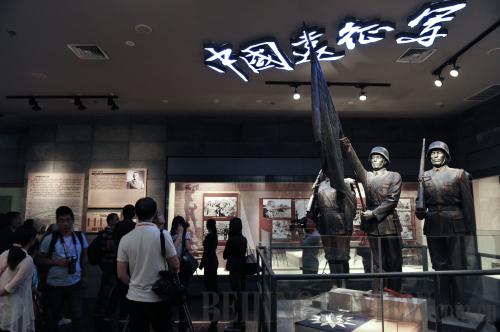 |
|
People visit the Memorial Hall of Resistance Against Japanese Aggression in Tengchong on August 13 (WEI YAO) |
China Expeditionary Army
On December 23, 1941, in the heat of the resistance war and WWII, representatives of China and Britain met in Chongqing of southwest China and signed a joint defensive pact on the Burma Road linking Burma with southwest China, marking the formation of the China and Britain military alliance. To protect southwest China and support Britain's fight against Japanese aggression in Burma, a British colony at that time, China built an expeditionary army to fight there. The China Expeditionary Force became a good example of military cooperation between China and the Allied Forces during WWII.
In March 1942, Chinese troops entered Burma, beginning battles along the Chinese-Burmese border that lasted three years and three months. China sent a total of 400,000 troops into the battlefield, with casualties making up nearly half this number.
The China Expeditionary Force had made major sacrifices to protect the Burma Road and had later constructed a road linking China and India. With the two life lines, ongoing international aid from Allied Forces could be transported to China.
The Chinese force fighting bravely in Burma also made a great contribution to the victory of Allied Forces in WWII. To a great extent, because of Chinese troops fighting against Japan in Burma, Britain was able to concentrate on the battlefields of North Africa and finally achieved strategic superiority against Nazi Germany in West Europe.
Copyedited by Kylee McIntyre
Comments to weiyao@bjreview.com | 